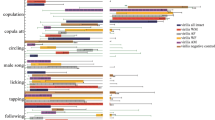Abstract
AlthoughDrosophila melanogaster males usually court virgin females vigorously, a male will perform very little courtship in response to a virgin female if he has previously been in the presence of a fertilized female. The normal courtship response is restored after approximately 3 h [Siegle, R. W., and Hall, J. C. (1979).Proc. Natl. Acad. Sci. USA 76:3430–3434]. Experiments designed to account for this phenomenon exclude the possibilities that the visible “rejection” behaviors performed by the fertilized female in response, to the male are either a necessary or a sufficient basis for the transitory decrement in courtship. A role for other visual, cues is also ruled out. However, mutant males with olfactory defects do court virgins after experiences with fertilized females. Also, males exposed to extracts from fertilized females while in the presence of a male or virgin female fly thereafter perform very little courtship with virgin females. Finally, we describe a new mutant strain whose males court and mate with wild-type, virgin females normally; but after such a mating, the wild-type female is readily courted by a wild-type male, and that male subsequently exhibits vigorous courtship of other females. Since both virgin and fertilized females can stimulate males to court them, these observations fuggest the following hypothesis. After fertilization by a wild-type male, a female becomes a source of an aversive chemical cue which is sensed by a courting male [cf. Tompkins, L., and Hall, J. C. (1981).J. Insect Physiol. 27:17–21]. The courting male associates that substance with the courtship-stimulating cues emanating from females which he subsequently encounters, and he therefore learns to avoid courting these females.
Similar content being viewed by others
References
Aceves-Piña, E. O., and Quinn, W. G. (1979). Learning in normal and mutnatDrosophila larvae,Science 206:93–96.
Anthony, C., and Jallon, J.-M., (1982). The chemical basis for sex recognition inDrosophila melanogaster.J. Insect Physiol. 28:873–880.
Booker, R., and Quinn, W. G. (1981). Conditioning of leg position in normal and mutantDrosophila.Proc. Natl. Acad. Sci. USA 78:3940–3944.
Connolly, K., and Cook, R., (1973). Rejection responses by femaleDrosophila melanogaster: Their ontogeny, causality, and effects upon the behaviour of the courting male.Behaviour 52:155–171.
Cook R., and Cook, A. (1975). The attractiveness to males of femaleDrosophila melanogaster: Effects of mating, age and diet.Anim. Behav. 23:521–526.
Duerr, J. S., and Quinn, W. G. (1982) ThreeDrosophila mutations that block associative learning also affect habituation and sensitization.Proc. Natl. Acad. Sci. USA 79:3646–3650.
Dudai, Y., and Quinn, W. G. (1980). Genes and learning inDrosophila, Trends Neurosci. 3:28–30.
Gailey, D. A., Jackson, F. R., and Siegel, R. W. (1982). Male courtship inDrosophila: The conditioned response to immature males and its genetic control.Genetics 102:771–782.
Gailey, D. A., Jackson, F. R., and Siegel, R. W. (1984). Conditioning mutations inDrosophila melanogaster affect an experience-dependent behavioral modification in courting males.Genetics, in press.
Grigliatti, T. A., Hall, L., Rosenbluth, R., and Suzuki, D. T. (1973). Temperature-sensitive mutations inDrosophila melanogaster. XIV. A selection of immobile adults.Mol. Gen Genet. 120:107–114.
Hotta, Y., and Benzer, S. (1976). Courtship inDrosophila mosaics: sex-specific foci for sequential action patterns.Proc. Natl. Acad. Sci. USA 73:4154–4158.
Jallon, J.-M., and Hotta, Y. (1979). Genetic and behavioral studies of female sex appeal inDrosophila.Behav. Genet. 9:257–275.
Le Moli, R., and Mainardi, M. (1972). Effect of recent experience with reproductive isolation betweenDrosophila melanogaster andDrosophila simulans.Ist Lombardo Accad. Sci. Lett. Rend. Sci. Biol. Med. B 106:29–35.
Mackintosh, N. J. (1974).The Psychology of Animal Learning, Academic Press, London, New York.
Manning, A. (1967). The control of sexual receptivity in femaleDrosophila.Anim. Behav. 15:239–250.
O'Hara, E., Pruzan, A., and Ehrman, L. (1976). Ethological isolation and mating experience inDrosophila paulistorum.Proc. Natl. Acad. Sci. USA 73:975–976.
Quinn, W. G., Harris, W. A., and Benzer, S. (1974). Conditioned behavior inDrosophila melanogaster.Proc. Natl. Acad. Sci. USA 71:708–712.
Rodrigues, V. (1980). Olfactory behavior ofDrosophila melanogaster. In Siddiqi, O., Babu, P., Hall, L. M., and Hall, J. C. (eds.)Development and Neurobiology of Drosophila, Plenum Press, New York, pp. 361–371.
Rodrigues, V., and Siddiqi, O. (1978). Genetic analysis of chemosensory pathway.Proc. Indian Acad. Sci. 87B:147–160.
Siegel, R. W., and Gailey, D. A. (1984). Mutations that affect associative learning inDrosophila also lead to defective conditioned courtship responses of the male (manuscript in preparation).
Siegel, R. W., and Hall, J. C. (1979). Conditioned responses in courtship behavior of normal and mutantDrosophila.Proc. Natl. Acad. Sci. USA 76:3430–3434.
Spieth, H. T. (1968). Evolutionary implications of sexual behavior in Drosophila. In Dobzhansky, T., Hecht, M. K., and Steere, W. C. (eds.),Evolutionary Biology 2 Appleton-Century-Crofts, New York, pp. 157–193.
Spieth, H. T. (1974). Courtship behavior inDrosophila.Annu. Rev. Entomol. 19:383–406.
Thorpe, W. H. (1963).Learning and Instinct in Animals, Methuen., London.
Tempel, B. L., Livingston, M. S., and Quinn, W. G. (1984). Mutations in the dopa-decarboxylase gene affect learning inDrosophila (submitted for publication).
Tompkins, L., and Hall, J. C. (1981a). The different effects on courtship of volatile compound from mated and virginDrosophila females.J. Insect Physiol. 27:17–21.
Tompkins, L., and Hall, J. C. (1981b).Drosophila males produce a pheromone which inhibits courtship.Z. Naturforsch. 36c:694–696.
Tompkins, L., Hall, J. C., and Hall, L. M. (1980). Courtship-stimulating volatile compounds from normal and mutantDrosophila.J. Insect Physiol. 26:689–697.
Tompkins, L., Gross, A. C., Hall, J. C., Gailey, D. A., and Siegel, R. W. (1982). The role of female movement in the sexual behavior ofDrosophila melanogaster.Behav. Genet. 12:295–307.
Author information
Authors and Affiliations
Additional information
This work was supported in part by U.S. Public Health Service Grants RO1 GM-21473 and 5 KO4 GM-00297 to JCH and by a grant from Temple University to LT.
Rights and permissions
About this article
Cite this article
Tompkins, L., Siegel, R.W., Gailey, D.A. et al. Conditioned courtship inDrosophila and its mediation by association of chemical cues. Behav Genet 13, 565–578 (1983). https://doi.org/10.1007/BF01076402
Received:
Accepted:
Issue Date:
DOI: https://doi.org/10.1007/BF01076402




